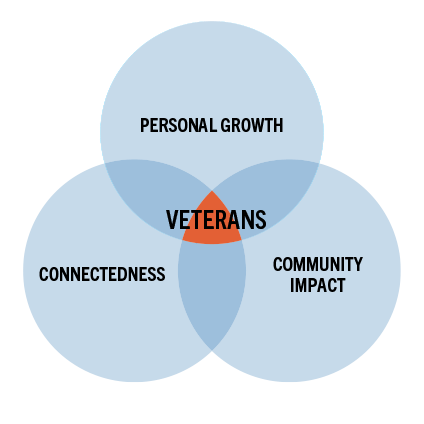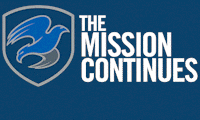The Empowered Veteran Index is a framework that guides the work we do and our offerings, so we remain focused on addressing the specific challenges and struggles that veterans reintegrating into civilian life face. It’s built on three equally important and interconnected components: Personal Growth, Connectedness, and Community Impact.
Everything is interconnected: veterans personally benefit from The Mission Continues as they learn skills, connect with other veterans and work together with people of different backgrounds. Their work is centered on under-resourced communities, where veterans are directly addressing the needs of community members. These overlaps produce a relationship in which several simultaneous benefits are occurring—ultimately adding up to our mission to help veterans use their power to benefit themselves and others.
The Empowered Veterans Index

Every one of our programs encompasses these three components
WHAT PERSONAL GROWTH LOOKS LIKE
- Job Readiness: Veterans learn skills that can be used in future employment or working in the community. Additionally, veterans learn how to translate skills learned in the military to a civilian context.
- Leadership: Veterans improve their leadership skills and have hands-on opportunities to manage a team.
- Purpose: Veterans rediscover a sense of purpose and motivation in their life.
- Empowerment: Veterans feel more confident and self-assured in their ability to set goals and meet them.
- Communication: Veterans feel confident they have the tools to confidently communicate their experience as a veteran—to other veterans as well as to non-veterans.
- Wellbeing: Veterans observe an increase in resiliency and ability to pursue and accomplish goals.
THE NEED IS CLEAR
Several studies of returning veterans show they often come home unprepared for civilian life.
A 2014 study conducted by the University of Southern California found:
- Nearly two-thirds of veterans in Los Angeles County reported feeling unprepared when they left the military
- 80% of veterans leave the military without a secured job
- At least 40% depart without a permanent housing plan
- The American Psychological Association reports indicates that on a single night, there are approximately 50,000 homeless veterans in the United States. Homelessness is often compounded by undiagnosed and untreated mental health issues
- Another barrier is the struggle with translating the skills learned and honed in the military to civilian obligation—something one study found 40% of returning veterans struggle with
The lack of preparedness can lead to a host of problems once veterans return home, including un- or under-employment, economic distress, homelessness, and physical and mental health issues.
HOW WE FILL THE GAP
Internal research indicates personal growth is a top motivator for veterans who participate in our programs.
In a 2017 survey of all program participants:
- A majority (55.5%) alluded to personal growth as one of the reasons they participated in our programs
- Nearly two in five (39%) cited finding a purpose as their reason for participating.
Moreover, many participants reported being motivated by an interest in furthering their careers/employment opportunities:
- 25.7% said they participated for professional development
- 15% sought a new career opportunity
Internal research also reveals that our programming effectively answers veterans’ needs for personal growth.
Among our program participants responding to the 2020 annual survey:
- 80% of veterans report feeling a stronger sense of purpose
- 84% felt they had the ability to make a difference in their community
A study of the Service Platoon Program (2014-2015) found:
- More than three in five (62%) participants report that their participation helped them become a leader
- Employment of participants increased 14 percentage points after participation in the program
- 32% of participants reported improved job performance
- 28% said their participation improved their chances of finding a job
Our internal research suggests personal growth through skill building, sense of purpose and achieving goals they have set for themselves (resiliency) are top motivators for veterans who participate in our programs and is an observable outcome that is produced through participation in The Mission Continues.
WE CONNECT VETERANS IN 3 WAYS
- Social support and camaraderie among veterans: We connect veterans with other veterans as teammates dedicated to service.
- Veteran/non-veteran divide: We connect veterans with teams of non-veterans working alongside each other to make a joint impact in their community.
- Professional networking: We provide additional opportunities for professional networking to facilitate veterans’ career prospects.
THE NEED IS CLEAR
Only about 1% of the U.S. adult population has served in the military, meaning most veterans are coming home to communities that may not understand their specific needs and experiences. The Department of Veterans Affairs identifies social isolation as a major risk factor for suicide, which itself has become an epidemic among the veteran community. The risk may be higher among older veterans whose social resources dwindle with age.
Moreover, women veterans experience especially high rates of isolation because of the many unique experiences they endure in the military. Social isolation, even when it does not lead to suicide, can have deleterious effects on veterans’ physical and mental health. One study found that its effect on mortality is similar to the effects of smoking and substance abuse. Furthermore, social isolation also affects employment outcomes, with those who are socially isolated, or low on “social capital,” being less likely to be employed.
Connecting veterans to other veterans has proven a successful strategy to reduce the effects of social isolation.
Studies of veteran peer support programs have concluded:
- Military related programs can help veteran reintegration by promoting relationship building
- They also create social networks that act as links to services and resources
A 2017 study of veterans who completed The Mission Continues civic service fellowship program found:
- Veterans reported decreased rates of social isolation and loneliness and an increased sense of social support
- Re-creating a familiar culture of camaraderie among veterans helps foster a sense of connectedness that helps veterans reintegrate into civilian life
While The Mission Continues’s programming will not directly address veterans’ mental health needs, it can reduce the burden of social isolation by connecting veterans with each other, as well as non-veterans. The connectedness our programs inspire can help veterans feel less alone and ultimately aid in their reintegration process.
HOW WE FILL THE GAP
Internal evaluations have found veterans cite connecting with other veterans among their top reasons for participating in our programs.
In a 2017 survey:
- More than two-thirds (67%) of participants said connecting with veterans was a reason they got involved with The Mission Continues
- Three-quarters of participants reported feeling more connected with other veterans’ post-participation with our programs
- 60% of veterans said they felt more connected to the non-veteran community
- More than three in five participants (63%) in the Service Platoon Program said they were able to build more networking opportunities through their participation
This sense of connection with other veterans is critical not only for support and camaraderie, but because veterans can help other veterans find the resources they need, like job opportunities or services for health needs.
Many times, veterans can make stronger connections with non-veterans in their lives once they develop the tools to communicate about their experiences as veterans and tell their stories to people in their lives.
The tools to communicate about one’s own experiences is part of the personal growth our programs help foster that allows veterans to foster that connection.
COMMUNITY IMPACT AT ITS CORE
- Tangible community benefits: Veterans use the skills they honed in the military to help and empower under-resourced communities in America. We work with a community or community organization to reach a pre-defined intended goal that they could not have reached without the service of veterans. This goal becomes our mission in that community.
- Bridging the divide between veterans and non-veterans: We create opportunities for veterans and non-veterans to connect and work together. The community has a better understanding of the needs of veterans or feels more closely connected to the veteran population. Veterans learn how to work with others of different backgrounds and develop a sense of empathy for the communities they work in.
- Further engagement: Veterans learn and recognize they can make a difference and impact people who need their help, which inspires them to continue serving in their own communities. This addresses veteran isolation and a sense of lacking purpose.
THE NEED IS CLEAR
Communities all across the country are facing uphill battles and unable to serve their constituencies. Many communities in America are under-funded and under-resourced.
Poverty is rampant and families living in poor communities are less likely to have adequate healthcare and more likely to be unemployed; educational resources are slim, food insecurity is widespread, and safety is of great concern. So many communities need support to solve their problems and lift up their families, but without resources, many communities’ problems only intensify.
Communities can benefit greatly from allowing The Mission Continues and their veteran participants to serve them.
Veterans are uniquely qualified to help disadvantaged communities because of the skills and mindsets they have honed through their military service, including:
- Problem-solving
- Endurance
- Team-focused
- Efficient
- Mission-driven
- Action-oriented
As a group, veterans have the ability to infuse American communities with fresh ideas, energy, and human capacity to problem solve and build stronger communities. Moreover, allowing veterans to impact communities through their service is the mechanism by which we promote personal growth and connectedness.
Substantial evidence indicates helping others boosts one’s overall happiness and wellbeing. Studies have found:
- Positively impacting the lives of others can help enhance one’s own sense of purpose as well as one’s resilience
- Helping others also increases empathy and one’s ability to understand one’s colleagues as well and the community they serve
When veterans return home, oftentimes they experience a feeling of being “lost,” without a sense of purpose. Their desire to continue serving and impacting people around them often goes untapped. Our programs can help fill that gap by creating opportunities for veterans to continue serving others and impacting communities that need their help.
Veterans also benefit from working in communities because they work alongside nonprofit organization partners, who are often non-veterans. This creates opportunities for veteran/non-veteran connections, but also allows veterans to practice working with people of different backgrounds.
At the same time, non-veterans can also gain a better understanding of the veteran population. Promoting empathy on both sides helps further alleviate the military/non-veteran divide that is common in workplaces, schools, and communities across America.
Stories of Impact
Get Involved
Serve again in your community, join one of our leadership development programs, and more.
GET INVOLVED You are successfully logged in.
You are successfully logged in.






